Basil or basil blooms in August and produces beautiful small white, pink or purple flowers. The herb is highly aromatic and contains essential oils. The inflorescence is a false wreath that surrounds the stem of the plant with six flowers. The flowers are edible and can be used in various applications. They give the dishes an extra flavor and aroma. It is even a good idea to cut the flowers off so that the plant can focus on new leaves.
- Basil (Ocimum basilicum)
- Annual plant in the Netherlands and Belgium
- Description of the green basil (Ocimum basilicum)
- Various hybrids of basil (Ocimum basilicum)
- Edible flowers
- Lipped flowers
- Taste
- Uses of basil flowers
- What you can do with the flowers of basil
- To keep
- More species from the genus Ocimum
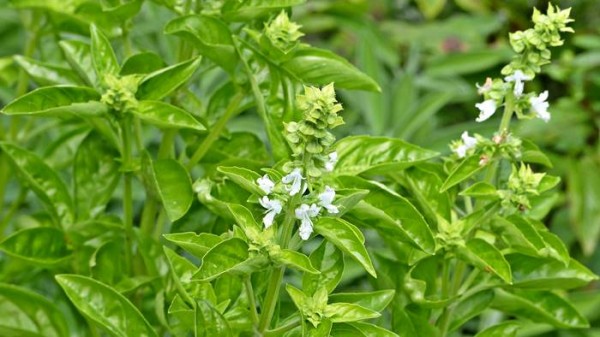
Basil (Ocimum basilicum)
Basil is a member of the Lamiaceae family and the Ocimum genus. The genus Ocimum has many herbaceous plants that are lignified at the base. Basil (Omimum basilicum) is a species of the genus Ocimum and is a fragrant culinary herb. Basil has terpenes, aromatic substances that give the smell and taste. They also contain essential oils.
Annual plant in the Netherlands and Belgium
Basil is a perennial plant in countries such as Italy and Spain. In the Netherlands and Belgium, basil is an annual plant because the first frost in autumn or a late night frost in spring freezes the plant outside. After the ice saints (mid-May), basil can be kept outside in the ground in spring (keep an eye on the weather forecast), but basil can also be kept indoors in the kitchen.
Description of the green basil (Ocimum basilicum)
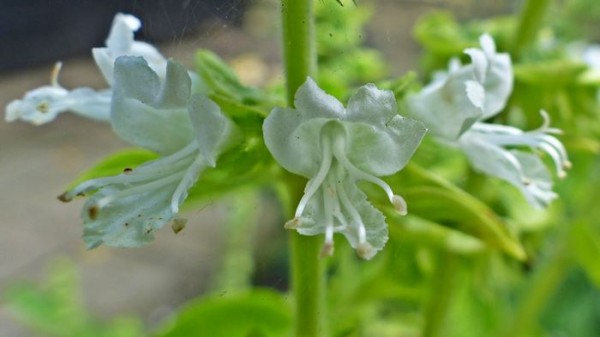
The annual basil grows to about 50 centimeters and has an upright habit. The plant blooms with small lip flowers at the end of July and beginning of August. For the plant it is better to cut the flowers so that all nutrients go to the plant. In the Netherlands and Belgium, the flowers will never produce seed. The flowers are edible and have the same taste as the leaves, but in a slightly softer shade. Just like marjoram, mint, savory, rosemary and thyme, basil owes its taste and aroma to special aromas and flavors, the so-called terpenes (special flavors and aromas). In addition, basil also contains essential oils.
Various hybrids of basil (Ocimum basilicum)
In the Netherlands and Belgium, basil is grown as an annual plant and basil (Ocimum) is widely cultivated for its fragrant and aromatic foliage in many types and varieties. The cultivated basil plants all have a sweet anise-like taste but can differ in leaf and flower color, leaf shape, flavor and flavor strength.
Cultivated plants such as:
- Ocimum basilicum Cinnamom Basil, this basil has medium sized cinnamon-scented leaves;
- Ocimum hybrid Blue Spice, a strong grower that does well in pots. Special is the vanilla, which is reflected in the aroma and taste;
- Ocimum basilicum Large Leaved, basil with extra large aromatic leaves;
- Ocimum americanum Lemon Basil is basil whose leaves spread a lovely fresh lime scent.
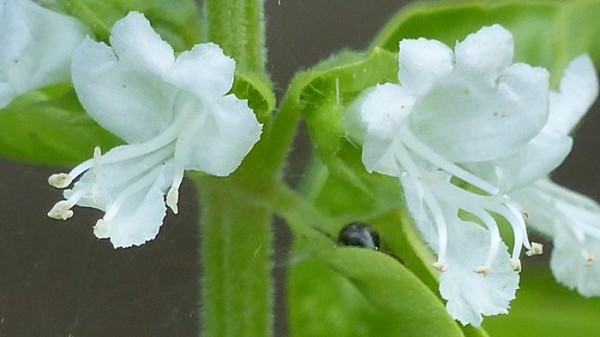
Edible flowers
Lipped flowers
The flowers are arranged in various false wreaths with six flowers around the stem. The little flowers don’t all bloom at the same time. Basil belongs to the lip-flower family (Lamiaceae) and owes its name to the typical shape of the petals, which have grown together to form an upper and lower lip.
Taste
The small basil flowers taste delicious and taste slightly sweeter than the basil leaf. The lower false wreaths, where the flowers have already fallen out, have the same taste. A sweet anise-like taste, the flowers of which provide an addition for use in, with and through food. The best are the young flowers (just out of bud or even half in bud). Older flowers can taste bitter.
Uses of basil flowers
Eating flowers is common in many countries. In the Netherlands and Belgium, eating flowers is a specific, often small, demarcated part. In restaurants you sometimes come across flowers on your plate and during holidays you can buy edible flowers in the supermarket. Flowers from your own garden are especially preferred because they are unsprayed. When the basil blooms in early autumn:
- pick the flowers in the morning after the dew but before the sun shines on them;
- keep them in a paper bag in the drawer of the refrigerator;
- freshen up before use on food by placing the flowers in ice-cold water for half an hour;
- remove the stem if necessary and dry carefully on a piece of kitchen roll.
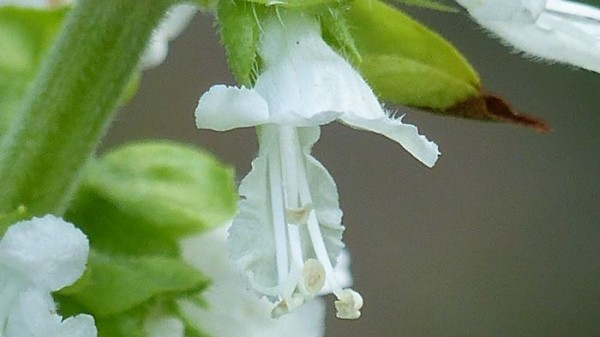
What you can do with the flowers of basil
The flowers of basil provide opportunities to:
- sugarify them;
- to process them in various dishes;
- to freeze them;
- to make spicy tea;
Sugaring
Carefully dip the basil flowers in egg white and then sprinkle with icing sugar. After this, the cake can be decorated with sugared basil flowers.
Various dishes
The basil flowers add value to hot dishes or cold dishes. Use the whole flower or several flowers, in cold dishes as a dessert, a sauce or in a salad. In hot dishes such as soup or with light meats. The warm, aniseed flavor as a flavor enhancer can possibly replace the salt pot.
Freezing
Fill an ice cube trailer half full with water. Place one or more flowers here and freeze it. After it is frozen, fill the rest with water and put it back in the freezer.
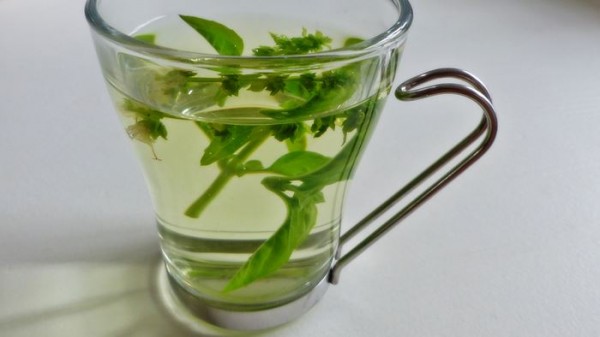 Tasty and fragrant basil tea.
Tasty and fragrant basil tea.Tea
Together with the leaves of the basil plant, the flowers are suitable for making tea. Preferably fresh or otherwise dried. Store dried herbs in a dark and cool place. Exposure to light and heat damage the essential oils and cause the herbs to lose their flavor.
To keep
Store the fresh edible flowers dry in the refrigerator at 2 ° C to 7 ° C. They can then be kept for about five days.
More species from the genus Ocimum
The green basil (Ocimum basilicum) originates from tropical Africa and Asia and belongs to the genus Ocimum. The genus Ocimum has several species such as:
- Ocimum campechianum. A plant found in Mexico, Central America, South America, the West Indies and Florida. A plant similar to the green basil (Ocimum besilicum), but with a sharper flavor;
- Ocimum americanum. Known as American basil or gray basil, and native to Africa, the Indian subcontinent, China, and Southeast Asia. The herb is used for medicinal purposes;
- Ocimum canum or African basil. Native to Africa, it has a minty taste and fragrant flowers;
- Ocimum sanctum or holy basil or Tulsi, synonym Ocimum tenniflorum, a sacred plant in India. The holy basil grows to a height of one meter and has red or purple flowers. A fresh spicy scent that is different from the green basil (Ocimum basilicum);
- Ocimum gratissimum or African basil or tree basil. A species that grows to a height of up to 120 centimeters. The species is found in Africa and South Asia;
- Ocimum kilimandscharicum also known as camphor basil. The camphor basil comes from Kenya, Tanzania, Uganda, Sudan and Ethiopia. The flowers spread a clove to camphor scent.
- Ocimum × citriodorum or lemon basil, Thai basil or Lao basil (Ocimum × citriodorum) is a cross of the green basil (Ocimum basilicum) and the African basil (Ocimum africanum). This spice has a strong lemon aroma and is sometimes also called “sweet”. called basil and is native to Southeast Asia. Where the European variety is green, Thai basil often has a purple glow over the twigs and sometimes also over the leaves.
The plant grows to between 30 and 100 centimeters, depending on the variety. The basil requires a lot of heat, light and water. Basil will flower in July-August (depending on the variety, location and temperature). The small lipped flowers bloom in white, lilac or purple.








